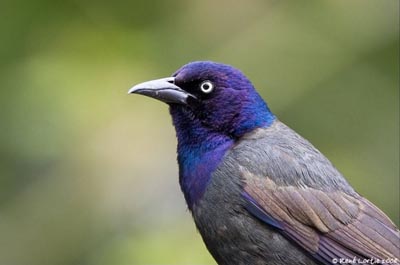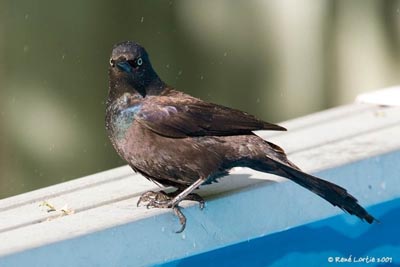
Common Grackle
Quiscalus quiscula
Passeriforme Order – Icteridae Family
BIOMETRICS:
Length: 28-34 cm
Wingspan: 36-46 cm
Weight: 74-142 gr
LONGEVITY: Up to 22 years
DESCRIPTION:
Common Grackle has a long, spoon-shaped tail, and a large, slightly decurved bill.
Adult male is glossy black all over, with a strong metallic sheen, purple on head and neck, bronze or purple on remainder of plumage (depending on population). It has striking pale yellowish eyes, and long graduate tail. Legs are dark.
Adult female is smaller than male. It’s duller black, especially on underparts, but also has pale yellowish eyes.
Juvenile is drabber sooty-brown and has dark eyes, but retains distinctive shape.
Albinism has been recorded fairly often in this species, but it’s usually partial.
Common Grackles are commonly parasitized by Brown-headed Cowbird.
Common Grackle is one of the most successful and widespread species in North America. They are very common but they are killed as an agricultural pest in many parts of their range.
Fr: Quiscale bronze
All : Purpurgrackel
Esp : Zanate Común
Ital: Gracchio comune americano
Nd: Glanstroepiaal
Russe: Обыкновенный гракл
Sd: Mindre båtstjärt
Photographs by René Lortie
His website: http://rlortie.ca/
Text by Nicole Bouglouan
Sources:
NEW WORLD BLACKBIRDS – THE ICTERIDS by Alvaro Jaramillo and Peter Burke – Helm - ISBN : 0713643331
FIELD GUIDE TO THE BIRDS OF NORTH AMERICA by National Geographic Society - National Geographic Society - ISBN: 0792274512
All About Birds (Cornell Lab of Ornithology)
Animal Diversity Web (University of Michigan Museum of Zoology)
What Bird-The ultimate Bird Guide (Mitchell Waite)
Wikipedia (Wikipedia, The Free Encyclopedia)

VOICE: SOUNDS BY XENO-CANTO
Common Grackle’s usual song is a loud, hoarse “chuk” or “chak”. Song is a wheezing, up slurred “tssh-shkleet”.
HABITAT:
Common Grackle is found in open grasslands, farmlands, parks and large gardens, and open woodlands, also in swamps, marshes and urban residential areas.
RANGE:
Common Grackle, breeds from NE British Columbia, E Idaho and W New Mexico, eastwards to the Atlantic and Gulf Coasts.
It winters from S Minnesota and S New England southwards.
BEHAVIOUR:
Common Grackles are very gregarious, even during breeding season. Birds that are not incubating roost together at night. Breeding pairs nest singly or in colonies of up to 200 pairs.
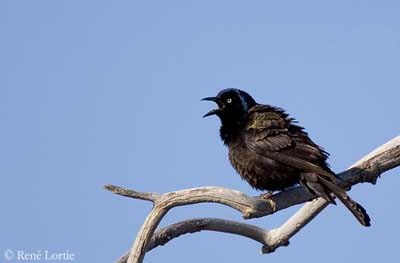
Common Grackles are territorial only around the nest site. They may attack intruders, biting, pecking, scratching and flying towards the adversary. Pairs strongly defend the nest by mobbing, chasing or diving at predators, including humans.
Common Grackles migrate in mixed-species flocks. Most birds make seasonal movements between breeding sites and wintering sites. Populations living in the Gulf Coast don’t migrate.
Common Grackles are usually monogamous. Pair formation begins in flocks in early spring. It’s indicated by flights and mutual displays between a single female and several males. Male and female show preference for one another by flying together. From pair formation and during incubation, male remains perched near its mate, following her and engaging in mutual displays. Once incubation begins, its attentiveness decreases steadily.
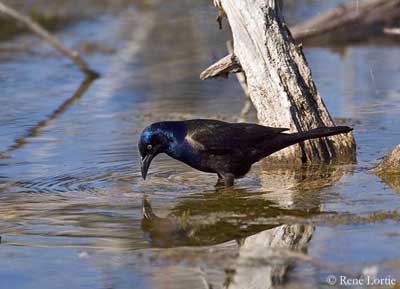
Common Grackles are very opportunistic foragers. They follow ploughs in search of grubs. Grackles forage primarily on the ground, but also utilize trees, shrubs and vegetation. They feed in large flocks, outside the breeding season. They use the bill instead of their feet to find food in the ground. They wade into water to catch small fish, and sometimes kill and eat other birds.
Common Grackles engage in anting, allowing ants to crawl on its body and secrete formic acid, possibly to rid it of parasites. But it uses several manners in addition to ants.
FLIGHT:
When Common Grackles arrive in their areas, the large flock takes off with a whir of wings.
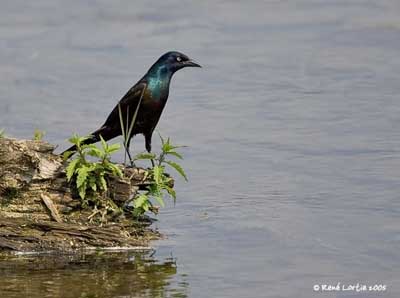
REPRODUCTION:
Nest site is chosen and built by female, in coniferous trees. But she may use other nests from other bird species.
Nest is large and bulky, made with woody stems, leaves and fine grasses, but also fishing line, feathers, manure and tape. Nest is lined with mud, and finally with grasses and horsehair.
Female lays 1 to 7 eggs, smooth-textured and variable in colour. Incubation lasts about 12 to 14 days, by female. About half of Common grackles males desert female and nest, but the others participle in parental care after hatching. Chicks are altricial. Young leave the nest about 12 to 15 days after hatching, and remain near the nest, for one or two days. Adults continue to feed them for several weeks.
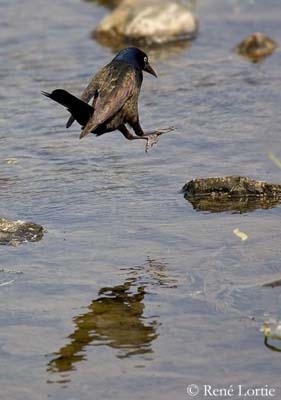
DIET:
During breeding season, Common Grackles eat mainly insects and other invertebrates. Their diet may also include goldfish (Carassius auratus), minnows (Pimephales notatus), crayfish (crabs, krill and shrimps), small frogs, salamanders, mice and small bats caught from the air.
During migrations and in winter, they eat mostly grains from farm fields, and seeds. They also eat some fruits.
PROTECTION / THREATS / STATUS:
Common Grackles are killed by humans to control population’s farm fields where they destroy crops.
They have some predators such as foxes, squirrels, rats, snakes, cats, raccoons which eat eggs and chicks. Raptors are predators of adults.
